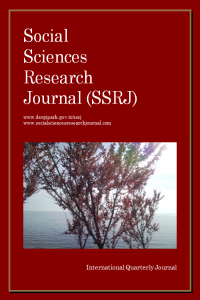Bilgi ve Haberleşme Teknolojilerinin Sağlık Göstergelerine Etkisi
Bilgi ve haberleşme teknolojileri, sağlık göstergeleri, kanonik korelasyon analizi
The Impact of Information Communication Technologies (ICT) on Health Indicators
Information and communication technology, health indicators, Canonical Correlation Analysis,
___
- Albayrak, A,S. (2006). Çok Değişkenli İstatistik Teknikleri, (1.Edition), (pp. 476) Ankara: Asil Yayınevi.
- Azevedo, V., Bouillon, C. & Galssman A. (2011). Development Connections Unveiling the Impact of New Information Technologies, (A. Chog, editor), USA.
- Baykal, A. (2009). Gelişim Göstergeleri Bağlamında Türkiye’nin Uluslararası Çerçeveden Görünümü, Boğaziçi Eğitim Dergisi 26(2), 1-13.
- Bolat B. A. (2004). İmalat Sanayinde Verimliliği ve Karlığı Etkileyen Faktörlerin Araştırılması, İstanbul Üniversitesi Sosyal Bil. Enstitüsü, Yayınlanmamış Yüksek Lisans Tezi, İstanbul, 56.
- Dobrota, M., Jeremic, V. & Markovic, A. (2012, November). A new perspective on the ICT Development Index, Information Development, 28 (4), 271- 280.
- Driouchi, A. (2013). ICTs for Health, Education, and Socioeconomic Policies: Regional Cases , IGI Global, USA.
- Hair, J. F. Jr., Anderson, R. E., Tatham, R. L. & Black, W. C. (1998). Multivariate Data Analysis (5th Edition). Upper Saddle River, NJ: Prentice Hall.
- Hardoon, D. R., Sedmak S. & Shawe-Taylor J. (2003). Canonical Correlation Analysis; An Overview with Application to Learning Methods , Technical Report, Royal Holloway University of London, 5.
- ITU (2014a), Measuring the information society report 2014-Executive Report, Geneva Switzerland.
- ITU (2014b) World Summit on the Information Society WSIS+10, High Level Event WSIS+10 Outcome Documents, Geneva, 2014.
- Kalaycı, Ş. (2006). SPSS Uygulamalı Çok Değişkenli İstatistik Teknikleri, (2. Edition), Ankara: Asil Yayın Dağıtım.
- Kırılmaz, H. (2005). Sağlık Sisteminin Sorunları ve Bilgi Teknolojileri, 2. Ulusal Tıp Bilişimi Kongresi/Medical Informatics ’05 Türkiye Bildiriler/Proceedings.
- Levine, M.S. (1977). Canonical Analysis and Factor Comparison. Thousand Oaks, CA: SAGE Publications, Inc.
- Micevska, M. (2006). Information and communication technologies for development and poverty reduction: The potential of telecommunications, (Torero M. & Von Braun J., editors), (312-336), Baltimore: The John Hopkins University Press.
- Mishra, S., Kalra, A. & Kavita Choudhary, K. (2013, November). Influence of Information and Communication Technology in Health Sectors, International Journal of Soft Computing and Engineering (IJSCE) ISSN: 2231-2307, 3 (5), 66-68.
- Saraçlı, Z. & Saraçlı, S. (2006, April). Eskişehir Osmangazi Üniversitesi İ.İ.B.F Öğrencilerinin Demografik Özellikleri ile Üniversite Sorunları Arasındaki İlişkileri Doğrusal Olmayan Kanonik Korelasyon ile İncelenmesi, Eskişehir Osmangazi Üniversitesi İktisadi ve İdari Bilimler Fakültesi Dergisi, I (I), 30.
- Tabachnick, B. G. & Fidell, L. S. (1996). Using multivariate statistics (3rd Edition). New York, NY: HarperCollins College Publishers.
- Tacq, J. (1999). Multivariate Technique in Social Sciences, Great Britain: Sage Publications. Tatlıdil H. (1996). Uygulamalı Çok Değişkenli İstatistiksel Analiz, (225) Ankara: Akademi Matbaa.
- Türedi, S. (2013). Bilgi ve İletişim Teknolojilerinin Ekonomik Büyümeye Etkisi: Gelişmiş ve Gelişmekte olan Ülkeler için Panel Veri Analizi, Gümüşhane Üniversitesi, Sosyal Bilimler Elektronik Dergisi, 7.
- WHO (2005). Connecting for Health. Global Vision, Local Insight. Report for the World Summit on the Information Society.
- WHO (2014). http://www.who.int/ [cited 2015 February 21]. World Bank (2004). World development report 2004. Making services work for the poor people. Washington, D.C: World Bank and Oxford University Press.
- World Bank (2012). http://data.worldbank.org [cited 2015 March 07]. World Bank (2015). http://data.worldbank.org/about/country-and-lending-groups [cited 2015 March 07].
- Wu, S.J. and Raghupathi, W. (2012). A Panel Analysis of the Strategic Association Between Information and Communication Technology and Public Health Delivery, J Med Internet Res. 14(5), 147.
- Yayın Aralığı: Yılda 4 Sayı
- Yayıncı: Denta Florya ADSM Limited Company
Müzelerde Gelir Yönetimi İçin Fiyat Farklılaştırması
H.Kemal Sezen, Fatma Sert Eteman, Arzu Eren Şenaras, Adem Kara
Telekomünikasyon Sektöründe Veri Toplama Yöntemleri, Yeni Yaklaşımlar Ve Güvenlik
The Performance of BB-MCEWMA Model: Case Study on Normal & Non-Normal Data
Nurul Hila Zainuddin, Muhamad Safiih Lola, Nur Shazrahanim Kamar
Denge Reel Döviz Kuru Tahmininde NATREX Modeli: Türkiye Uygulaması
Selahattin GÜRİŞ, Benan BÜYÜKMUMCU
F.merve PARLAKYILDIZ, E.alper GÜVEL
Türkiye İçin Yapılan Nedensellik Uygulamaları Üzerine Literatür Araştırması
Özgür ENGELOĞLU, İsa Gürkan MERAL, Kübra GENÇ
Evaluating the Energy Resources in Turkey Under Economic Growth and Increasing Energy Demand
Analysis of Oil Well Drilling Costs in Different Locations with PERT-CPM Project Planning Techniques
İller Arası Göç Tahmini İçin Bir Çekim (Cazibe) Modeli Önerisi
